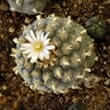Background
- Lophophora williamsii, also known as peyote, is found primarily in dry regions from central Mexico to Texas, particularly in regions along the Rio Grande. Peyote is commonly used in rituals and as a hallucinogen (due to its mescaline content). In 1990, the U.S. Supreme Court ruled that states may prohibit the use of peyote for religious purposes. Although peyote is illegal, the Dona Ana cactus, Coryphantha macromeris (Engelm.) Br. and R. and its runyonii (Br. and R.) L. Benson variety have been promoted as natural and legal psychedelic agents with about one-fifth of the potency of peyote.
- To date, there are no available clinical trials investigating the use of peyote for any indication. However, preliminary study investigating peyote has not found long-term cognitive deficits, although more study is needed to make any firm conclusions about peyote's safety.
- Some experts believe that proper use of one psychoactive substance, such as peyote, within a spiritual or clinical context helps to free an individual from the adverse effects of their addiction to another substance and thus restores them as functioning members of their community or group.
References
- Bullis RK. Swallowing the scroll: legal implications of the recent Supreme Court peyote cases. J Psychoactive Drugs 1990;22(3):325-332.
View Abstract - Calabrese JD. Spiritual healing and human development in the Native American church: toward a cultural psychiatry of peyote. Psychoanal Rev 1997;84(2):237-255.
View Abstract - Carod Artal FJ. [Neurological syndromes associated with the ingestion of plants and fungi with a toxic component (II). Hallucinogenic fungi and plants, mycotoxins and medicinal herbs]. Rev Neurol 5-16-2003;36(10):951-960.
View Abstract - de Rios MD, Grob CS, Baker JR. Hallucinogens and redemption. J Psychoactive Drugs 2002;34(3):239-248.
View Abstract - Fickenscher A, Novins DK, Manson SM. Illicit peyote use among American Indian adolescents in substance abuse treatment: a preliminary investigation. Subst Use Misuse. 2006;41(8):1139-1154.
View Abstract - Franco-Molina M, Gomez-Flores R, Tamez-Guerra P, et al. In vitro immunopotentiating properties and tumour cell toxicity induced by Lophophora williamsii (peyote) cactus methanolic extract. Phytother Res 2003;17(9):1076-1081.
View Abstract - Gilmore HT. Peyote use during pregnancy. S D J Med 2001;54(1):27-29.
View Abstract - Halpern JH, Sherwood AR, Hudson JI, et al. Psychological and cognitive effects of long-term peyote use among Native Americans. Biol Psychiatry 10-15-2005;58(8):624-631.
View Abstract - Hashimoto H, Clyde VJ, Parko KL. Botulism from peyote. N Engl J Med 7-16-1998;339(3):203-204.
View Abstract - Henry JL, Epley J, Rohrig TP. The analysis and distribution of mescaline in postmortem tissues. J Anal Toxicol 2003;27(6):381-382.
View Abstract - Huttlinger KW, Tanner D. The Peyote way: implications for Culture Care theory. J Transcult Nurs 1994;5(2):5-11.
View Abstract - Lu BY, Woofter C, Escalona R. A case of prolonged peyote-induced psychosis resolved by sleep. J.Clin Psychiatry 2004;65(10):1433-1434.
View Abstract - Nolte KB, Zumwalt RE. Fatal peyote ingestion associated with Mallory-Weiss lacerations. West J Med 1999;170(6):328.
View Abstract - Padula PA, Friedmann LW. Acquired amputation and prostheses before the sixteenth century. Angiology 1987;38(2 Pt 1):133-141.
View Abstract - Schwartz RH. Mescaline: a survey. Am Fam Physician 1988;37(4):122-124.
View Abstract







